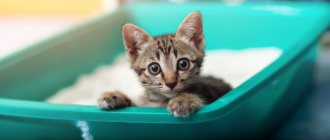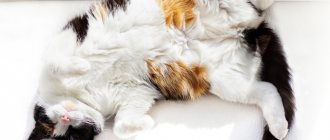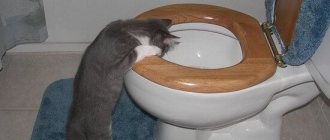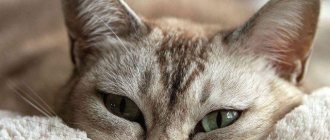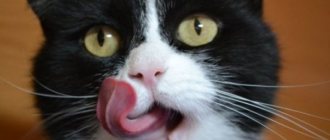If your cat is having trouble swallowing, it may be a sign of an underlying condition that needs to be treated as soon as possible.
Every pet coughs or gags while eating from time to time, but if you notice that your cat is consistently having difficulty swallowing, it's time to see your veterinarian to determine the cause. In addition to coughing and vomiting, cats may also drool, make repeated attempts to swallow, or adopt unusual postures to eat food when they experience this condition, called "dysphagia." If left untreated, cats may begin to lose weight quickly because they are unable to eat.
Symptoms of Difficulty Swallowing in Cats
There are three types of dysphagia, each of which can present with specific symptoms.
Oral dysphagia
- Struggling to open the mouth or keep food in the mouth
- Collect food from the sides of the mouth
- Throws back head to eat
© shutterstock
Pharyngeal dysphagia
- Repeated attempts to swallow
- Gagging
- Coughs
- Drooling
- Blood stains in saliva
- Excessive chewing before attempting to swallow
- Unusual movements of the neck and head while eating
Cricopharyngeal dysphagia
- Regurgitation of food
- Weight loss
- Loss of appetite
- Repeated attempts to swallow
- Gagging
Types of dysphagia
Fights cause dysphagia.
Swallowing disorders are divided into anatomical and functional. Morphological dysphagia can be congenital or acquired due to injury. Functional ones develop as a result of inflammatory or neurological diseases.
Based on localization, the following types of disorders are distinguished:
- Oral: The animal is unable to grasp food or form a bolus using the tongue and mouth. The cat chews for a long time, shaking its head so that the food falls into the throat.
- Pharyngeal: the relationship with the swallowing and gag reflexes is disrupted. Some of the food is regurgitated and ends up in the nasal passages. If the larynx becomes blocked, the pet dies from suffocation.
- Esophageal or esophageal. Food gets stuck in the esophagus and does not enter the stomach. A cough occurs, causing vomiting. The animal is starving and quickly loses weight.
Causes
Each of the different types of dysphagia is caused by different factors.
Oral dysphagia may be caused by:
- Paralysis of the jaw or tongue
- Muscle swelling
- Mouth injury
- Dental disease or infection
Pharyngeal dysphagia may be caused by:
- Cancer
- Enlarged lymph nodes near the throat
- Abscesses
- Inflammation of the pharynx
Cricopharyngeal dysphagia may be caused by:
- Tight or wasted muscles
- Nerve damage
In some cases, the reason why a cat cannot swallow may be neurological. If your cat suffers from a brain disease or rabies, dysphagia may be one of the side effects of this condition.
How is treatment and prevention carried out?
When something starts to interfere with your pet’s mouth and throat, it’s worth taking the cat to the veterinarian. This measure will allow you to prevent dangerous diseases or begin their treatment in time. In case of a pathological process in the pharynx, treatment with antiseptics and herbal decoctions with an astringent effect is required. During treatment, they adhere to a special diet and give the cat liquid food. Antibiotics are also prescribed for diseases that are complicated by a purulent process. Sore throat in cats and other diseases of similar localization are observed less frequently when preventive measures are carried out. For this purpose, monitor the animal’s diet and brush its teeth. It is not recommended to give your cat bones or other hard objects that could cause injury.
Diagnosis of problems
If you repeatedly notice that your cat is unable to swallow, take her to the vet as soon as possible. Tell your veterinarian what symptoms you notice, when they first appeared, and how often they occur. If your cat is injured or has suffered any form of trauma, be sure to notify your veterinarian.
© shutterstock
After discussing your cat's symptoms, your veterinarian may perform diagnostic tests to better understand your cat's health. First, a complete blood test, urine test, and biochemical profile will be performed to determine if your cat has an infection or muscle injury.
Veterinarians may also do x-rays of the mouth, skull, and chest, as well as an ultrasound of the pharynx. These tests are done to determine if there is any structural damage or growth. If growths are found, your veterinarian will likely take a biopsy to check for cancer cells.
At this point, the veterinarian should determine that the cat has dysphagia. But your veterinarian may still need to perform a test known as a fluoroscopic barium swallow to see how your cat swallows. During this test, your cat is given food and barium while the veterinarian monitors swallowing using a video x-ray device. This will help the veterinarian figure out where the problem is in the cat's mouth and throat.
Signs of a swallowing disorder
Owners do not always pay close attention to the process of eating their pets. If an animal has congenital defects that prevent it from swallowing, and a person has no experience in caring for a cat, he may not even realize that his pet cannot eat normally. There are several main signs that allow you to suspect a swallowing disorder in your pet:
- profuse salivation, sometimes mixed with blood;
- regurgitation and coughing during or after eating;
- gagging when trying to swallow a bolus of food;
- chewing food on one side of the mouth;
- nasal discharge, crusting on the face, bad breath;
- changes in appetite and weight loss;
- general muscle weakness of the animal;
- violation of the symmetry of the head or neck.
If a cat has two or three signs, it must be shown to a specialist.
What to do
The treatment plan for dysphagia will depend on the underlying cause. If an infection is causing the problem, antibiotics will be prescribed, but if the problem is inflammation, steroids may be prescribed instead. Both of these medications may need to be administered to your cat at home for up to ten days.
If a tight or contracted muscle is causing your cat to gag and cough, your veterinarian may prescribe muscle relaxers to help the muscle relax and allow your cat to swallow.
If the cause is some kind of structural damage or abscess, surgery may be required to correct the problem.
If the biopsy shows that there are cancer cells in the abscesses, your veterinarian will discuss various chemotherapy and radiation treatment options with you.
Finally, dental disease may need to be treated by removing infected teeth and administering antibiotics.
Causes and symptoms of diseases
What is the danger of a foreign body?
If a kitten is constantly or at least occasionally allowed to chew bones and other hard foods, then there is a high probability of sores in the mouth. If a foreign body gets into the cheek or between the teeth, the cat becomes painful and feels uncomfortable. A similar danger for outdoor cats is represented by sticks and wood chips, which damage the mucous membranes or get stuck in the throat. It is possible to recognize the entry of a foreign body by the pet's frequent rubbing of the oral cavity in an attempt to get rid of the object.
Veterinarians emphasize to owners that if a cat cannot quickly eliminate a foreign body on its own, then it is necessary to contact a veterinarian. The specialist removes the object in the mouth under local or general anesthesia.
Manifestation of acute stomatitis
When viruses or external irritants enter the oral mucosa, stomatitis may develop.
In kittens and adults, this disease is an inflammatory process of the oral mucosa that rapidly progresses. If stomatitis is not treated in time, it will be accompanied by pharyngitis and glossitis, as a result of which the pet’s tongue and throat become inflamed. The following negative factors can influence the progression of oral disease in cats:
- Calicivirus infection or herpes virus activity. Pathogenic microorganisms lead to an inflammatory process in which the pet experiences frequent sneezing, coughing and discharge from the nose and eyes. The animal develops ulcerative wounds of varying sizes.
- Irritation. This reaction can occur in a cat to chemicals, dyes, bleaches and other items used by humans in everyday life. If a large amount of such solutions is swallowed, the kitten may not be saved.
- Dental diseases and gingivitis. In cats, the tissue around the teeth is often damaged and inflamed, which leads to ulcers and other lesions of the mucous membrane.
How to recognize ulcerative wounds?
When a pet has one red spot or multiple wounds on the inside of the lip, this may indicate the formation of eosinophilic ulcers. Veterinarians classify this disease as a dermatological pathology. Without treatment, the number of wounds and their size increase and bleed. The neoplasm has a pinkish tint and causes severe pain to the cat, especially when eating.
Is squamous cell carcinoma dangerous?
The formation of a tumor prevents the pet from swallowing, and is a dangerous manifestation that can cost the cat’s life.
When a cat feels unwell, has difficulty swallowing and swelling in the mouth, this may indicate the presence of such a tumor. The neoplasm is part of the cancer group and, if not treated in a timely manner, can lead to death for the animal. The disease affects the oral cavity, pharynx, tongue and lips. To eliminate the pathology, radiation exposure to squamous cell carcinoma and its further surgical removal are required. According to statistics, when a cat is diagnosed with a malignant tumor of this type in the early stages, in 95% of cases it is possible to completely cope with it.
Cleft lip: what is it?
It is a congenital disease that can be eliminated through several plastic surgeries. If there is a violation, the cat has a defect in the upper lip, which is not completely completed. You can notice the irregular structure already in the first days after the kitten is born. With a mild form, the pet does not have any difficulties. If the cat’s case is advanced, and the cleft lip not only interferes with eating, but also the animal can hardly withstand the pain due to a cleft palate, then the veterinarian makes a decision on euthanasia (euthanization).
Cleft palate
When a cat has difficulty swallowing food and water, this defect may be the reason. The disease is often genetic in nature, and is often combined with a cleft lip. The pathology is noticeable in the kitten in the first days and causes him discomfort and does not allow him to drink milk normally due to a disturbed nasopharynx. The disease is characterized by other symptoms:
Due to disorders of the nasopharynx, it is difficult for the animal to drink milk from the first days of life, as it enters the respiratory system.
- frequent sneezing;
- difficulty breathing and noise when inhaling;
- pain syndrome;
- slow growth of kittens;
- the development of pneumonia due to milk entering the respiratory system.
Malignant tumor: what are the causes?
If your cat has difficulty swallowing and other unpleasant symptoms in the pharynx and oral cavity, then it is worth checking the animal for oral cancers. A predisposing factor to the development of cancer in cats is old age, but there are many other reasons due to which a malignant tumor forms in the pharynx. In most cases, treatment is temporary and only prolongs the pet’s life for a short time.
The essence of salivary gland diseases
Such diseases are rarely recorded in cats, and they occur with the following symptoms:
- the animal swallows frequently;
- swelling appears under the tongue and on the neck;
- pain syndrome;
- blockage of the salivary ducts.
Sore throat or tonsillitis?
Sore throat is accompanied by high fever and requires drug treatment.
Some believe that these are the names of two different pathologies, but this is not so. Sore throat and tonsillitis are one and the same thing, as a result of which the cat experiences inflammation of the swallowing ring, accompanied by swelling of the throat and tonsils. When a pet gets sick, it feels like something is bothering them when eating, and the temperature rises to 40 degrees or higher. The disease is most often of bacterial origin. Sore throat in cats is treated with a liquid diet and penicillin antibiotics.
Appearance of Jacobs ulcer
It forms in the middle part of the lip and rarely affects the cat’s pharynx or oral mucosa. It is a small yellow or red spot, which soon turns into purulent erosion. Veterinarians still do not know the sources of the disease, but the following possible causes are identified:
- viral leukemia;
- infectious dental diseases in cats;
- allergic reaction.
Recovery
If the cause of your cat's inability to swallow was not cancer, he or she will recover within one to two weeks. But cats will have difficulty eating food while they are recovering from dysphagia, so you are responsible for making food easier until they get better. Talk to your veterinarian about ways you can make your cat more comfortable and help her eat her food. For example, your veterinarian may recommend that you feed your cat only soft, mushy foods that will slide down your cat's throat easily. Or your veterinarian may recommend that you position your cat in a certain way when feeding. In extreme cases, when the cat has lost significant weight, the veterinarian may keep her on a feeding tube while she recovers.
Any medications prescribed by your veterinarian should be used as recommended. Be sure to bring your cat in for a follow-up exam so the vet can make sure everything is healing properly.
Causes of swallowing disorders
Gingivitis
The swallowing process is disrupted under the influence of the following pathogenic factors:
- Mechanical: occur when a foreign object is inserted into the soft tissues of the mouth or the food tube is blocked. An embedded fish bone causes pain and interferes with the act of swallowing. A curious pet plays with small parts of toys or devices scattered on the floor, swallows them and blocks the lumen of the pharynx or esophagus.
- Traumatic: damaged soft tissues become inflamed and swollen, pain or narrowing of the food passage due to a formed scar prevents swallowing.
- Congenital: anatomical abnormalities prevent the normal passage of the food coma. Most often they occur during spontaneous selection, when mating partners are not selected taking into account pedigrees.
- Errors in feeding , in which food particles are retained on the gums. Plaque occurs, tartar forms, and gingivitis develops. The act of swallowing becomes painful.
- Inflammation of the lymph nodes due to hypothermia from frozen food, burns that are too hot, and infectious diseases.
- Formation of ulcerative defects of the mouth as a result of calicivirus infection.
- Paralysis of the masticatory muscles due to tick-borne or viral infection, poisoning, autoimmune processes.
- Swelling of the pharynx under the influence of irritating factors
- Traumatic brain injuries.
- Tumors.
Be sure to read:
What to do, the cat is sneezing, the eyes are watery or festering, reasons



